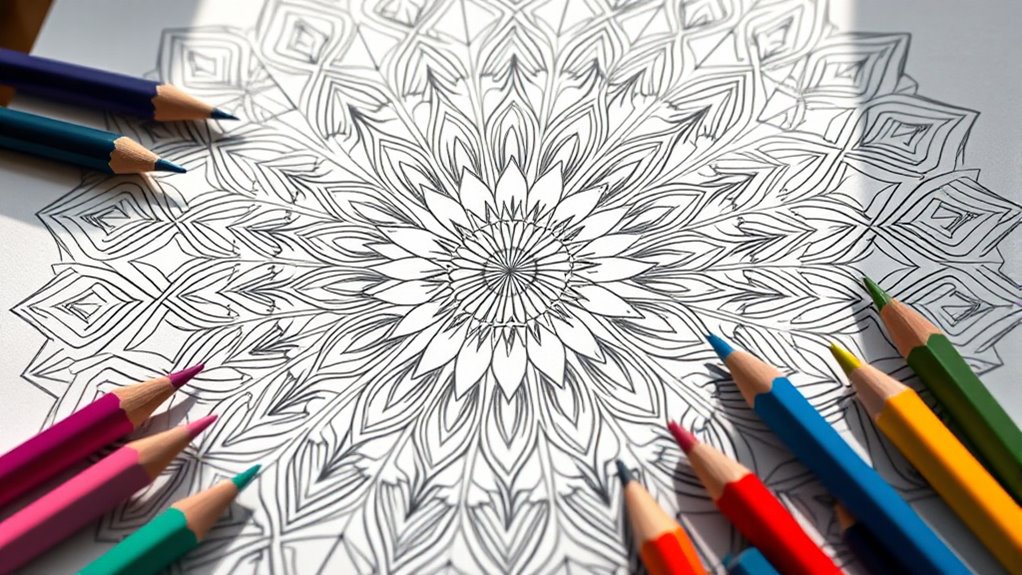Mandala drawing and coloring can markedly reduce stress by engaging your focus on repetitive patterns and symmetry, promoting mindfulness and emotional healing. As you select colors and create intricate designs, you’ll feel more relaxed and centered, turning art into a calming daily practice. Using quality materials and exploring different styles helps deepen your connection. If you keep exploring, you’ll discover ways to personalize your mandalas and incorporate them into your routine for ongoing peace.
Key Takeaways
- Engaging in mandala drawing and coloring promotes mindfulness, helping to reduce stress and foster emotional healing.
- Creating symmetrical patterns encourages present-focused meditation, calming the mind and alleviating anxiety.
- Using calming colors and intricate designs enhances relaxation and facilitates emotional expression.
- Incorporating regular mandala activities into daily routines reinforces stress management and mental clarity.
- Sharing and reflecting on mandala artwork can deepen self-awareness and promote emotional well-being.
The Therapeutic Benefits of Mandala Art

When you engage in creating or coloring mandalas, you tap into a powerful form of mindfulness that can reduce stress and promote emotional healing. This practice encourages mindfulness meditation, helping you stay present and focused on each detail. As you draw or color, your mind shifts away from worries, fostering a sense of calm and clarity. The repetitive patterns and symmetry serve as a meditative anchor, allowing your thoughts to settle. Over time, this can lead to emotional healing by releasing negative emotions and promoting inner balance. Mandala art provides a safe space for self-expression and reflection, making it a therapeutic tool for managing anxiety and enhancing overall emotional well-being through mindful engagement. Additionally, incorporating meditative practices like yoga alongside mandala art can further deepen relaxation and emotional resilience.
Getting Started With Mandala Drawing

Are you ready to begin your mandala drawing journey? Start by focusing on the basics of creating geometric patterns, which form the foundation of most mandalas. Use simple shapes like circles, triangles, and squares to build your design, allowing you to develop symmetry and balance. As you draw, consider color symbolism—think about how different colors evoke specific emotions or meanings. This awareness can deepen your connection to the process and enhance your stress reduction. Incorporating mindfulness techniques into your practice can further promote relaxation and mental clarity. Don’t worry about perfection; the goal is to engage your mind and foster mindfulness through repetitive, harmonious shapes. Begin with a light sketch, then gradually add details, letting your intuition guide your choices. This mindful approach makes your mandala a personal, calming expression.
Choosing the Right Materials for Coloring

Choosing the right materials can make your coloring experience more enjoyable and satisfying. Consider investing in quality coloring tools, like smooth crayons or vibrant colored pencils, to bring your mandalas to life. Also, pick suitable mediums and comfortable surfaces that support your style and help you stay relaxed while coloring. Incorporating community engagement into your art practice can also inspire new ideas and improve your technique.
Quality Coloring Tools
To achieve vibrant and precise colors in your mandala drawing, selecting high-quality coloring tools is essential. Good coloring tools enhance your artistic techniques, allowing you to blend, shade, and highlight with ease. Invest in quality pencils, markers, or pens that deliver smooth application and rich pigmentation. Using inferior tools can lead to uneven coloring, frustration, and less satisfying results. When choosing your coloring tools, consider how they feel in your hand and their ability to produce consistent, vibrant hues. Well-made tools also last longer, making your coloring practice more enjoyable and economical. Additionally, choosing tools that support color accuracy can help you achieve more true-to-life and visually appealing results. Remember, the right tools can elevate your mandala art, helping you relax and express your creativity more effectively.
Suitable Coloring Mediums
Selecting the right coloring mediums can make a significant difference in how your mandala turns out. The type of art supplies you choose impacts the vibrancy, texture, and overall effect of your design. For beginners, colored pencils offer control and precision, making them ideal for detailed work. Markers provide bold, vibrant colors and quick application, perfect for adding contrast. If you prefer softer blends, consider watercolor paints or gel pens, which add a delicate touch. Each coloring medium has its unique qualities, so choose based on your desired outcome and comfort level. Using suitable art supplies helps reduce frustration and enhances relaxation, making your mandala coloring experience more enjoyable and stress-relieving. Additionally, understanding different coloring mediums can help you select the best tools for your artistic preferences and achieve the desired calming effects.
Comfortable Coloring Surfaces
A comfortable coloring surface is essential for a smooth and enjoyable mandala coloring experience. The right surface features soothing textures that prevent your hand from slipping and reduce fatigue, making the process more relaxing. Look for materials with ergonomic designs, providing ideal support for your hand and wrist as you work. Soft, smooth surfaces like textured drawing pads or sturdy craft mats can enhance control and comfort. Avoid hard or uneven surfaces that cause discomfort or hinder your precision. Choosing a surface with the right grip and cushioning helps you focus on your art without distraction. When your workspace feels comfortable and supportive, you’ll find it easier to immerse yourself in the calming rhythm of mandala coloring, reducing stress and increasing mindfulness. Additionally, selecting ergonomic workspace solutions can further optimize your comfort during extended coloring sessions.
Techniques to Enhance Focus and Mindfulness

Have you ever noticed how focusing on intricate patterns can quiet your mind? When you engage in mandala drawing or coloring, you naturally enter a state of mindfulness meditation. Concentrating on the details helps you stay present, reducing mental clutter. To deepen your focus, try breathing slowly and deliberately as you work on your mandala, enhancing your mindfulness practice. This focused attention can also facilitate emotional release, allowing you to process feelings without judgment. By setting aside dedicated time for this activity, you create a space for calm and clarity. Over time, these techniques strengthen your ability to stay centered, making it easier to manage stress and stay mindful throughout your day. Incorporating mindfulness techniques into your routine can further amplify the stress-reducing benefits of your mandala practice.
Incorporating Mandalas Into Your Daily Routine

Integrating mandalas into your daily routine can create a simple yet powerful practice for ongoing mindfulness. You might set aside a few minutes each morning or evening to draw or color a mandala, turning it into a calming mindfulness exercise. This consistency helps reinforce a sense of presence and tranquility, making stress easier to manage. Incorporate mandala activities into activities you already do daily, like taking a break at work or winding down before bed. By making it a habit, you embed mindfulness into your everyday life, fostering a peaceful mindset. Over time, this routine can enhance your overall well-being, providing a reliable method to reconnect with yourself and reduce stress amidst busy schedules. Understanding sound design techniques can also inspire calming auditory backgrounds to complement your mandala practice.
Exploring Different Styles and Patterns

As you explore incorporating mandalas into your routine, experimenting with different styles and patterns can deepen your appreciation for this art form. You might try geometric patterns, which add symmetry and a modern touch, or incorporate cultural motifs that connect you to specific traditions and histories. Mixing these styles allows for creative expression and keeps your practice fresh. Pay attention to how different patterns influence your mood and focus, helping you find what resonates most. Whether you prefer intricate, detailed designs or bold, simple shapes, exploring various styles broadens your understanding of mandalas. This variety not only enhances your artistic skills but also enriches your stress reduction journey, making each coloring session more engaging and meaningful. Additionally, exploring different styles can mirror the offensive and defensive tactics used in ethical hacking, broadening your perspective and fostering a deeper sense of balance and security.
Tips for Creating Your Own Unique Mandalas

Creating your own unique mandalas begins with understanding that there are no strict rules—your design should reflect your personal style and intentions. To do this, consider the symbolic meanings behind shapes, colors, and patterns, which can add depth and significance to your artwork. Incorporate cultural influences that resonate with you, whether inspired by spiritual traditions, nature, or personal experiences. Experiment with different motifs and arrangements, allowing your intuition to guide you. Remember, the goal is to create a piece that feels authentic and meaningful. Trust your instincts and don’t be afraid to deviate from conventional patterns. Your mandala should be a reflection of your inner self, blending symbolism and cultural influences in a way that promotes relaxation and self-expression. Embracing creative practice can also help you develop a more intuitive approach to your designs, making each mandala uniquely yours.
Sharing and Reflecting on Your Artwork

Sharing your mandala artwork offers an opportunity to gain new perspectives and deepen your understanding of your creative process. When you share your progress with others, you can receive valuable feedback and encouragement that motivate you to keep exploring. Reflecting on your emotions as you discuss your mandala helps you connect more deeply with your feelings and the calming effects of your art. This process allows you to see how your mood influences your design choices and vice versa. By opening up about your work, you foster a sense of community and self-awareness. Additionally, understanding the importance of feedback in creative growth can help you approach sharing with a growth mindset. Ultimately, sharing and reflecting on your mandala creations turn your art into a meaningful tool for stress reduction and personal growth.
Frequently Asked Questions
Can Mandala Drawing Help Manage Specific Mental Health Conditions?
Yes, mandala drawing can help manage specific mental health conditions. It encourages meditation techniques, helping you focus and calm your mind. As you create detailed patterns, you actively engage in emotional expression, which can reduce anxiety and improve mood. Regularly practicing mandala art provides a mindful outlet for emotions, making it a useful complementary tool for managing conditions like depression and PTSD.
How Long Should I Spend on Each Mandala Session for Stress Relief?
A mandala session can feel like a mini vacation for your mind, so aim for 20 to 30 minutes per session. Follow the duration guidelines to prevent burnout and make it a regular habit. You might do this 3 to 4 times a week, allowing your stress to melt away gradually. Consistency is key—short, focused sessions will give you the best stress relief and mental clarity over time.
Are There Cultural Considerations to Respect When Creating Mandalas?
When creating mandalas, you should be mindful of cultural considerations like avoiding cultural appropriation and respecting religious symbolism. You shouldn’t replicate sacred symbols without understanding their significance, and avoid using motifs that might be offensive or misrepresentative. Instead, focus on appreciating and learning about their cultural roots. This respectful approach enriches your experience and honors the traditions behind the mandalas, fostering a meaningful and considerate practice.
What Are Common Mistakes Beginners Make in Mandala Coloring?
One common mistake you make is coloring outside the lines, which can break the mandala’s symmetry and disrupt its calming effect. You might also struggle with symmetry errors, accidentally unevenly coloring sections that should mirror each other. To avoid these, take your time, use fine-tipped coloring tools for precision, and double-check your work to maintain balance. Remember, perfection isn’t the goal—relaxation and enjoyment are!
How Can I Incorporate Mandala Art Into Therapeutic or Educational Settings?
You can incorporate mandala art into therapeutic or educational settings by using it as a calming group activity in therapy sessions or classroom activities. Encourage participants to focus on creating intricate patterns, which promotes mindfulness and emotional expression. Facilitate discussions about their designs and feelings, fostering self-awareness and connection. Mandalas serve as a versatile tool to reduce stress, enhance concentration, and support emotional well-being in both group therapy and educational environments.
Conclusion
As you complete your mandala, imagine it as a blooming flower, each petal representing your calm and clarity. Let your colors and patterns flow like a gentle stream, washing away stress. Remember, your artwork is a mirror of your inner peace—unique and vibrant. Keep drawing and coloring, allowing your inner light to shine through each intricate design. Embrace this mindful journey, and watch your stress dissolve into the harmonious circle you’ve created.









